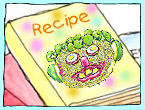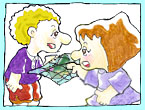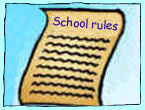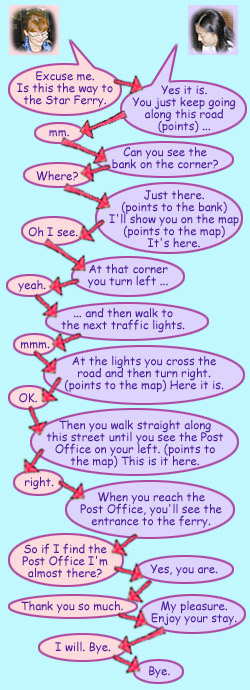Communicative functions: Interacting with others
| Asking people to do things |
Giving and responding to instructions, directions and rules
 |
Instructions enable us to achieve goals. For example, recipes are instructions which enable us to cook different types of food. |
|
 |
Directions enable us to reach a goal. For example, we give tourists directions to help them find their way around Hong Kong. |
|
 |
Rules tell us how to
behave in different places: |
|
| School rules tell students how they should behave at school. | ||
| The road rules tell us how to behave when we driving or walking on the road. | ||
| Rules tell us how to play games such as soccer, tennis or Monopoly | ||
When we give instructions, directions and rules, we are giving Commands.
When we give Commands in written language we use a list of imperative
clauses. In instructions the list of Commands is in a sequence which we must
follow in order to achieve the goal of
the instructions.
Here are some instructions for
making the frame of a kite:
|
|
1. Cut 5 pieces of string, each 20 cm
long.
2. Soak the bamboo in warm water until it can bend easily. 3. Carefully bend the bamboo to the correct shape.4. Then tie the bamboo securely with the string. |
Here is a list of school rules. School rules include prohibitions which are
negative Commands beginning with don't. These rules are not in a
sequence. All these rules apply all the time:
 |
Be quiet when others are talking. Put your hand up to talk.Don't run in the classroom. |
Here are some spoken language directions given to a tourist asking the
way. The speaker puts the word you in front of the imperative clauses
which makes the directions seem more personal and less like Commands.
The directions are given in a sequence:

For more information see:
![]() Text
types: Instructions: Overview
Text
types: Instructions: Overview
![]() Text
types: Texts for social interaction: Directions
Text
types: Texts for social interaction: Directions
![]() Grammar: Clause: Using clauses to interact: Making
Commands
Grammar: Clause: Using clauses to interact: Making
Commands
Teaching activities |
| For PrimeTeach teaching activities which provide
KS2 students with practice in giving instructions, directions and rules,
and responding to instructions, directions and rules, see:
|
|
Tell me more ... Introduction |
|
||
To give us feedback about this section, click here or on the Comment button at the top of the screen.
If you have any questions about this section, visit the Language Corner.
If you have any questions or suggestions about how to teach this section, send a message to the Teaching Corner.